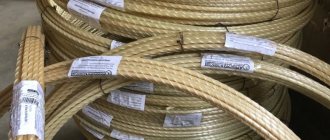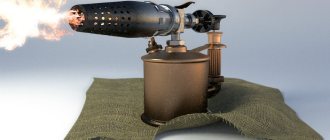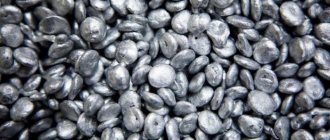- March 23, 2020
- Construction
- Vera Matveeva
Reinforcement is one of the most important components of a reinforced concrete foundation. It helps to influence the loads. Thanks to it, a bending moment arises. As for concrete, it copes with this quite poorly on its own. Therefore, it is necessary to install steel elements in it. But, before purchasing fittings and installing it, it is imperative to study the information about it.
Types, brands of fittings
When choosing a material, you should definitely take into account the following characteristics of the reinforcement:
- View.
- Class.
- Steel grade. Rods are made from it.
Currently, there are three main types of reinforcement in construction. These include the following:
- Hot rolled. Such fittings are usually designated as A.
- Ropeway. This type has its own designation in the form of the letter K.
- Cold-formed. It is designated as Vr.
Hot rolled steel is used for the foundation. It is produced in accordance with GOST 5781 -81*. As for cold-worked steel, it is also used for foundations, but very rarely. Before installing it, limit state calculations are required. But rope reinforcement is more durable, but its laying for construction is not economically profitable.
Very often people ask what class of reinforcement is needed for a foundation? It is worth noting that for the construction of the house, reinforcement is used, the class of which is not lower than A400. Some manufacturers still continue to use the old markings; in this case, it is necessary to order fittings with a class of at least A111.
From the point of view of economy, you can choose a higher class, but it is unprofitable. But as for steel classes A240 and A400, they should under no circumstances be used for foundations.
It is very important to choose it wisely when purchasing steel. If we are talking about building a private house, then, as a rule, no problems arise when choosing. And if the amount of work is much larger, then the rods should be ordered at the factory. To do this, you need to fill out an application and indicate the steel grade. If this is not specified in the application, the plant will appoint it itself.
Types of fittings by purpose
Quite often people do not know what kind of reinforcement is needed for the foundation? All fittings, depending on their purpose, can be divided into three main types. It is worth noting that some types of structures in construction are not used for their intended purpose. Their division provides for many regulatory documents that regulate the design of house foundations. Such documents include, for example, the joint venture “Concrete and reinforced concrete structures”.
According to their purpose, as well as their location, the fittings can be divided into the following types:
- Working reinforcement. The location of the reinforcement directly depends on the types of foundation. So, for example, when used with a strip foundation, the rods are laid in one or even two rows, at the bottom and at the top of the strip. As for the slab foundation, its working reinforcement is as follows: rods or meshes are located in both directions. Moreover, it is worth noting that the thickness of the foundation greatly affects the number of rows of grids or rods. If it is 150 mm, or even less, then they are laid in one row.
- Vertical reinforcement, in which clamps are located between two rows of reinforcement. At the same time, they ensure their joint work. Such reinforcement is not used when the thickness of the structure is 150 mm, or even less.
- Transverse reinforcement. This reinforcement consists of horizontal clamps. Thanks to them, the joint operation of individual working rods is ensured. This type is ideal for building a strip foundation for a house. And for pouring monolithic slabs its use is not required.
How much rod do you need?
Having developed a strip foundation reinforcement scheme, you know how many longitudinal elements you need. They are laid around the entire perimeter and under the walls. The length of the tape will be the length of one reinforcement rod. By multiplying it by the number of threads, you get the required length of the working reinforcement. Then add 20% to the resulting figure - a margin for joints and overlaps. This is how much in meters you will need working reinforcement.
You count how many longitudinal threads according to the diagram, then calculate how many structural rods are needed
Now you need to calculate the amount of structural reinforcement. Calculate how many crossbars there should be: divide the length of the tape by the installation pitch (300 mm or 0.3 m, if you follow the recommendations of SNiP). Then you calculate how much it takes to make one lintel (add the width of the reinforcement cage with the height and double it). Multiply the resulting figure by the number of jumpers. You also add 20% to the result (for connections). This will be the amount of structural reinforcement to reinforce the strip foundation.
Using a similar principle, you calculate the amount needed to reinforce the sole. Putting everything together, you will find out how much reinforcement is needed for the foundation.
You can read about choosing the brand of concrete for the foundation here.
Reinforcement diameter
Professional builders can also tell you what kind of reinforcement is needed for the foundation. Before you make your choice, you must decide on its diameter. This issue is regulated by the joint venture “Concrete and reinforced concrete structures”, as well as the “Manual on the reinforcement of elements of monolithic reinforced concrete buildings”.
For example, the minimum diameter for clamps in no way depends on the type of foundation of the house.
What diameter of reinforcement is needed for the foundation? The above documents specify the necessary values, these include the following:
- The diameter of vertical clamps that have a height of foundation structures of less than 80 cm is at least 6 mm.
- The diameter of horizontal transverse clamps, which are used only for strip foundations, is no more than 6 mm.
- The diameter of vertical clamps of foundation structures that are more than 80 cm should not be less than 8 mm.
With this information, you can quickly decide how to choose fittings. In this case, another additional condition is that the cross-section of the clamps should not be less than 0.25 of the diameter of the working reinforcement.
Main types of fittings
In order to know what kind of reinforcement is needed for the foundation, you must first familiarize yourself with the range. Currently, the modern construction market offers a huge selection of products designed to strengthen concrete, as well as create reinforced concrete structures.
Thanks to this knowledge, the question will no longer arise about what kind of reinforcement is needed for the foundation of a house. In order to strengthen the foundation, the following types of products may be suitable:
- Reinforcement made of composite material. It is made from plastic of various compositions. This material is very durable. Its main distinguishing feature is the lack of electrical conductivity, as well as high corrosion resistance. Products made from composite materials are quite expensive. As for private construction, this material is used quite rarely.
- Metal products. Represents standard steel rods of various diameters. To produce such products, it is necessary to use steel of various grades containing carbon. This material has fairly high strength characteristics. Thanks to this, the reinforced structure can withstand heavy loads and also withstand torsional and tensile forces.
Composite materials can be divided into several categories. These include the following:
- Fiberglass. It has high corrosion resistance and a fairly low thermal conductivity. Thanks to testing by specialists, we can say that this material is able to withstand extreme tensile loads.
- Carbon fiber. This product contains a small amount of diamond chips, as well as graphite. These elements have high fracture strength and also have high impact resistance.
- Basalt. Basalt is the main element in this material. It is a melt of certain rocks. It is woven into plastic threads, and reinforcement is made from these threads. Basalt can be used in cases where wireless signals, including radio waves, are required to enter the room.
In the construction of large industrial buildings, as well as cottages, metal products with very high electrical conductivity are mainly used, and are also quite simple to install.
Reinforcement surface
Many people wonder what kind of reinforcement is needed for a foundation? Let's take a closer look. The reinforcement can have completely different surfaces. These include the following:
- Corrugated. There are special protrusions on the surface of this product. Thanks to them, the most durable connection with the concrete mixture is ensured. Moreover, such material can have a completely different shape: crescent-shaped and even combined. The most durable is the crescent shape. Therefore, it is used most often in the construction industry.
- Smooth. This product does not have a profile on the surface. Because of this, the material does not have good adhesion to concrete. In most cases, rods are used to make floor screeds.
Fastening with plastic clamps
This is another way to connect reinforcement elements. The cost of such fastenings is higher than traditional wire.
Similar special plastic clamps are also used when securing elements of composite reinforcement.
Marking of reinforcement for foundation
The marking shows the strength and class of the material. In order to choose a suitable material for strengthening, it is imperative to pay attention to these indicators. Conventionally, we can distinguish the following categories that you need to know. These include the following:
- A 300. The materials are made from high-quality hot-rolled steel. This product has a ring-type corrugated surface. Ideal as a structural material, as well as for the construction of a one-story building with a light load.
- A240. This material is made from hot rolled steel. The fittings have a smooth surface. Its diameter is completely different, it can vary from 6 to 40 mm. It is practically not used as working elements. It is mainly used for connecting clamps.
- A 600. This material is quite durable. Thanks to this, it can be used for the construction of multi-storey buildings with high loads.
- A400 and A500. These materials are quite durable. They have a corrugated surface. Ideal for strengthening foundations. The diameter of such a product can vary from 6 to 40 mm.
What should you consider when purchasing?
When the calculation of the amount of reinforcing material required is completed, 5% must be added to it. When going to the store or to the base, take a caliper with you to check the declared diameter of the rods.
Note! Products must have a passport, a certificate of conformity, and a sanitary certificate. The batch documentation must contain the following product parameters: steel grade, wire diameter, class, manufacturer.
When performing a visual inspection of the product, make sure there is no plastic deformation, corrosion, or mechanical damage. Small spots of rust are not dangerous because they will help the concrete bond better with the metal.
To compare the cost, let's give an example: let's compare how effective the use of 40,000 m.p. fiberglass and rolled metal D = 10 mm. Let's take steel reinforcement grade A-III (A400) of the required design capacity with D = 10 mm.
| Reinforcement brand | Material | Strength | Volume, m cubic. | Weight, kg | Price, rub. |
| A-III (A400) D=10 mm L=40 km | Steel | Required design | 12,56 | 24 800 | RUB 694,400 (at the rate of 28,000 rub./t or 17 rub./m.m.) |
| Fiberglass D=10 mm L=40 km | Composite | 2.5 times higher than required | 12,56 | 5 600 | 880,000 rub. (at the rate of 22 rubles/m.m.) |
| Fiberglass D=6 mm L=40 km | Composite | Equal to required | 4,52 | 1 440 | 440,000 rub. (at the rate of 11 rub./m.m.) |
Tape type base
Before deciding what brand of reinforcement is needed for a strip foundation, you need to understand what this type of foundation is. This option is cost-effective and one of the most popular. It is actively used in the construction of cottages and private houses. This type of foundation has many advantages. These include the following:
- The materials are quite durable compared to other varieties. It is least susceptible to deformations of various types.
- Can be used to furnish a basement.
- It is definitely recommended to use a rod of a certain diameter. Many people ask what diameter of reinforcement is needed for a strip foundation? The diameter should be 12 mm. It is not recommended to use a product with a large diameter.
Many people are interested in what kind of reinforcement is needed for a strip foundation? For these purposes, rods of classes are used: A1 and A3. They are produced by the hot-rolled method.
A240 fittings have a smoother surface. Most often it is used for longitudinal strapping. As for the A300 rods, they have greater strength.
If you have this information, subsequently there will be no questions about what kind of reinforcement is needed for a strip foundation.
What and how to knit
Let's figure out how the reinforcing mesh is knitted. It is not recommended to use a welding machine for these purposes, and all connections are made with binding wire.
This work is best done using a crochet hook. A wire folded in half is threaded into it, the hook is threaded into the loop and twisted tightly until the free play disappears. The main advantages of this method are ease of implementation and reasonable cost, but the performance leaves much to be desired. A novice specialist will make up to six connections in one minute, a master – from fifteen to twenty.
All you have to do is lay the reinforcement in a strip or other foundation and tie it together. Some professionals prefer to use knitting guns. It is pressed to the intersection point and the trigger is pressed - the wire is quickly pulled through, creating a strong knot. The use of such a device allows you to almost double productivity. There are also negative aspects - the cost of the gun is high, and you will have to use a special wire so as not to break the tool.
For knitting, you can use black or galvanized wire. If the material is hard and you don't know how to bend it, heat it over a fire. In addition, knowing how to bend knitting wire, you can extract it yourself from old tires.
Another convenient solution for tying reinforcement in formwork is clamps made of plastic material. It is especially good to use such “frogs” (for reinforcement) to connect rods in the corners of the base.
Slab variety
Thanks to this type of foundation, it is possible to make the building more durable and reliable. For its reinforcement, rods with a diameter of about 16 mm are used.
Monolithic slabs are used in cases where it is planned to deviate from standard parameters during construction.
Very often, many people wonder what kind of reinforcement is needed for a monolithic foundation slab?
Monolithic slabs have increased rigidity, and their purchase is a cost-effective option. The only thing is that at low temperatures they are difficult to install.
As for the reinforcement for a monolithic slab, its diameter should be about 13 mm. The choice primarily depends on the load that will be placed on the slab during its use.
If you have this information, subsequently there will be no questions about what kind of reinforcement is needed for a monolithic foundation.
Connection methods
The strength of the foundation is given not by the reinforcement itself, but by the frame made from it. The structure is connected in two ways:
- Welding. Used infrequently, for large-scale construction. The method has a number of disadvantages. Only rods marked with the letter “C” are welded. The connection is characterized by increased rigidity, which does not have the best effect on the functioning of the entire frame. Small deformations of the foundation are inevitable, and in order for the reinforcement to cope with its role, some freedom of movement is needed at the connection points of elements located in different planes. Welding does not give such an effect, and the primary strength of the rods is reduced.
- Knitting. The intersection points of the frame are connected using a special binding wire. This gives the structure the necessary freedom, while fully maintaining its strength. The method is used when working with metal and plastic. Some disadvantages are considered to be that joining with wire takes more time, but a special tying gun can be used.
It is better to give preference to knitting, so the foundation will be more reliable











